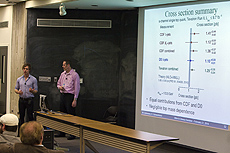|
Monday, Feb. 24
- Breakfast: blueberry crepes
- Breakfast: sausage, egg and cheese croissant
- Philly-style cheesesteak with peppers
- Smart cuisine: chicken creole
- Brazilian beef stew with rice
- Spicy Asian chicken wrap
- Stir fry sensations
- Navy bean soup
- Texas-style chili
- Assorted pizza by the slice
Wilson Hall Cafe menu
|
|
Wednesday, Feb. 26
Lunch
- Shrimp and sausage gumbo
- Mixed green salad
- Bread pudding
Friday, Feb. 28
Dinner
Closed
Chez Leon menu
Call x3524 to make your reservation.
|
|
Scientists complete the top quark puzzle
 |
Matteo Cremonesi, left, of the University of Oxford and the CDF collaboration and Reinhard Schwienhorst of Michigan State University and the DZero collaboration present their joint discovery at a forum at Fermilab on Friday, Feb. 21. The two collaborations have observed the production of single top quarks in the s-channel, as seen in data collected from the Tevatron. Photo: Cindy Arnold
|
Scientists on the CDF and DZero experiments at the U.S. Department of Energy's Fermi National Accelerator Laboratory have announced that they have found the final predicted way of creating a top quark, completing a picture of this particle nearly 20 years in the making.
The two collaborations jointly announced on Friday, Feb. 21, that they had observed one of the rarest methods of producing the elementary particle — creating a single top quark through the weak nuclear force, in what is called the s-channel. For this analysis, scientists from the CDF and DZero collaborations sifted through data from more than 500 trillion proton-antiproton collisions produced by the Tevatron from 2001 to 2011. They identified about 40 particle collisions in which the weak nuclear force produced single top quarks in conjunction with single bottom quarks.
Top quarks are the heaviest and among the most puzzling elementary particles. They weigh even more than the Higgs boson — as much as an atom of gold — and only two machines have ever produced them: Fermilab's Tevatron and the Large Hadron Collider at CERN. There are several ways to produce them, as predicted by the theoretical framework known as the Standard Model, and the most common one was the first one discovered: a collision in which the strong nuclear force creates a pair consisting of a top quark and its antimatter cousin, the anti-top quark.
Collisions that produce a single top quark through the weak nuclear force are rarer, and the process scientists on the Tevatron experiments have just announced is the most challenging of these to detect. This method of producing single top quarks is among the rarest interactions allowed by the laws of physics. The detection of this process was one of the ultimate goals of the Tevatron, which for 25 years was the most powerful particle collider in the world.
"This is an important discovery that provides a valuable addition to the picture of the Standard Model universe," said James Siegrist, DOE associate director of science for high energy physics. "It completes a portrait of one of the fundamental particles of our universe by showing us one of the rarest ways to create them."
Read more
|
Summer dreams
 |
| It isn't summer yet, but the recent warming reminds that winter's end is approaching. Until then, enjoy this diorama-illusion photo of what Fermilab will be like in a few months' time. Photo: Marty Murphy, AD |
|
Lunch and Learn demo: using Blue Cross Blue Shield, Prime Therapeutics online tools
On Jan. 1, medical coverage for Fermilab employees transitioned to Blue Cross Blue Shield and Prime Therapeutics.
Blue Cross Blue Shield and its prescription drug partner Prime Therapeutics offer online tools for Fermilab employees. On Wed., Feb. 26, at noon in One West, employees are invited to attend a Lunch and Learn live demo to learn how to navigate the tools.
Feel free to bring a bag lunch.
|
New neutrino may have heated baby universe
From Science, Feb. 21, 2014
Last March, when cosmologists working with the Planck spacecraft released the most detailed study yet of the afterglow of the big bang — the cosmic microwave background (CMB) — many researchers were disappointed that the European Space Agency mission merely confirmed the standard cosmological theory and found nothing new. Or did it? In separate papers, three groups of theorists now argue that when combined with other data, the Planck data show evidence of a new particle called a sterile neutrino, something that the Planck team had dismissed.
"At second glance, the universe might turn out to be less boring than initially thought," says Jasper Hasenkamp, a cosmologist at New York University (NYU) in New York City and co-author of one of the papers.
Read more
|
|
Managing the ecosystem
 |
| Coyote 351 was initially tagged in Schaumburg, Ill., but he made his way to Fermilab in 2010 and spent his summer splitting time between Batavia neighborhoods and Fermilab — totally oblivious to human boundary lines. Photo: Greg Vogel, AD
|
Soon the snow will all be gone, and we will once again be outside enjoying the outdoors in an unfrozen state (trust me on this!). A large part of our efforts to manage and care for this site will involve conservation and restoration efforts in our natural areas. How do we go about allocating limited resources to bring the most environmental value to the site?
One guiding principle is ecosystem management. While it's natural to think that our efforts should be directed at helping individual species or even a particular community, managing the ecosystem is much more effective, but also more complex. An ecosystem can be defined roughly as the living organisms in a location interacting with the nonliving elements of their environment in a systematic way. Ecosystem management recognizes the complex dynamic workings of ecosystems.
The ecosystem management concept implies that ecological boundaries and human-imposed boundaries rarely coincide. As an example, several years ago, we were able to track a coyote that spent roughly half his time on the Fermilab site and half in the adjacent Batavia neighborhood — very different environments with a clear (and dangerous) boundary.
One aspect of ecosystem management is adaptive management: the idea that various elements of the ecosystem are dynamic and that management must adapt. Things change. A very large-scale example is global climate change, but we see this dynamism even at the site level. For instance, the water table in the Main Ring has steadily risen in the last 10 years due to operational factors, and the plant community has adapted to the change, as has our management of it.
The most general goal of ecosystem management is to maintain ecological and evolutionary processes, such as nutrient cycles and ecosystem maturation. We are working toward the restoration of ecosystem function — not necessarily the reestablishment of the pre-settlement structures. In order to do that, we need some temporal stability in order to keep long-term processes relevant. That's why the laboratory campus is such a good place to undertake this type of work: In terms of ecology, it experiences very little change and has been relatively stable over the four-plus decades the lab has been here. Lastly, and in some ways most importantly, we strive to establish a meaningful relationship between the natural ecosystem and the human beings who work within it.
—Rod Walton
|
New employees - February
The following regular employees started at Fermilab in February:
Mark Adamowski, PPD; Robert Carrara, CS; Dennis Hundley, TD; Christopher Jacobsen, FI; Joshua Kaluzny, TD; Dawn McWha, FESS; Kimberly Myles, CCD; Michael Wesley, AD; Madelyn Wolter, PPD.
Fermilab welcomes them to the laboratory.
|
|